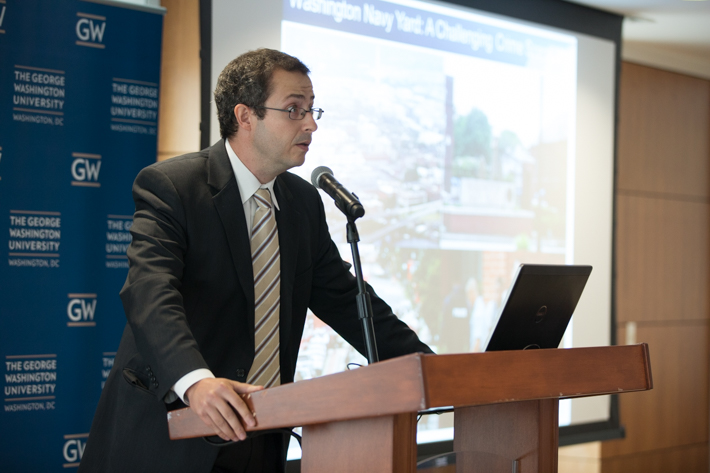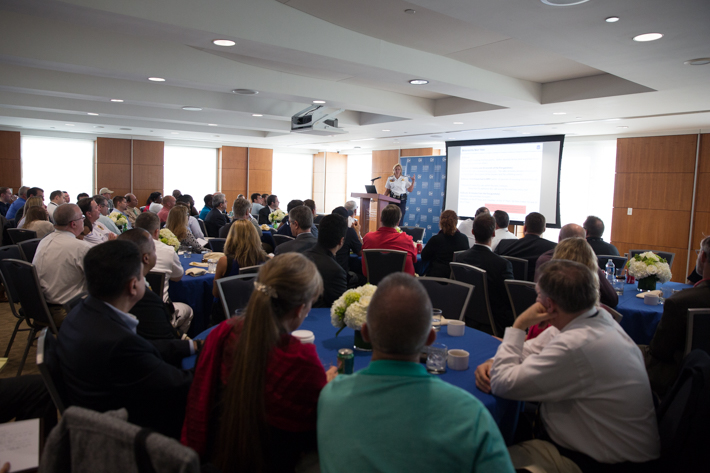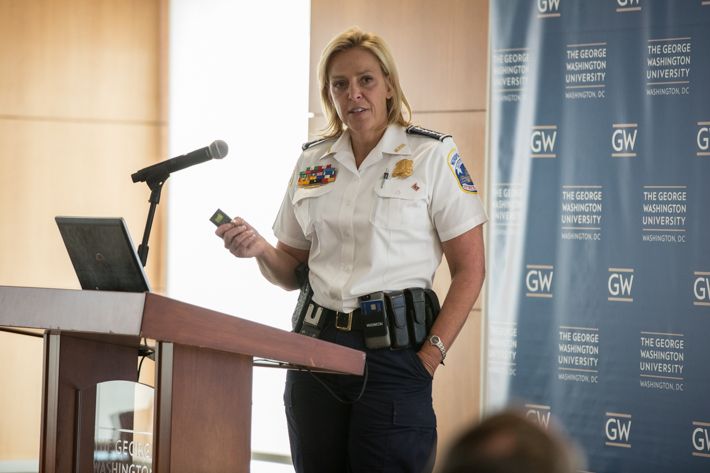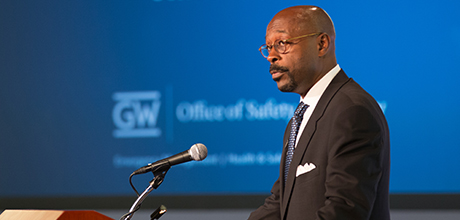By James Irwin
Cathy Lanier was on her way to work on Sept. 16, 2013, when she received a call about a homicide in Building 197 at the Washington Navy Yard. When the chief of the D.C. Metropolitan Police Department arrived on the scene she found a chaotic setting.
The military base was locked down. A half-dozen people were dead—maybe more. Law enforcement radios were flooded with dispatches. The police did not have access to security cameras inside the building.
Officers were moving into Building 197’s large, exposed atrium. An active shooter was mobile, somewhere inside a maze of long, narrow hallways and clustered cubicles. A fire alarm soon began sounding.
“It was the worst tactical nightmare you could imagine,” Chief Lanier said. “It was the absolute worst environment to go looking for a shooter.”

Frederic Lemieux, program director of the Security and Safety Leadership and Police and Security Studies programs in the College of Professional Studies, said hosting an event on the Navy Yard shootings is important for several reasons. "I think it’s important to go through and discuss the law enforcement and emergency response—to try and identify the challenges to improve response in the future, and to understand what changes need to happen," he said.
A year after the Navy Yard shooting there remain many lessons to learn regarding the response and managing of events involving active threats, Chief Lanier said Wednesday at the George Washington University, where she spoke for 45 minutes at an event sponsored by the Security and Safety Leadership and Police and Security Studies programs in the College of Professional Studies.
“The Navy Yard was a very challenging event,” said Frederic Lemieux, professor and program director of the two sponsoring programs. “It happened on a military base, it happened in the D.C. area, with different agencies involved in emergency management.”
The shooting left 12 dead and three wounded. It is the second-deadliest shooting rampage on a U.S. military base behind the 2009 Fort Hood shootings. The Navy Yard scene presented several obstacles related to communication, coordination and response, Dr. Lemieux and Chief Lanier said.
Many of those challenges involved the setting. As a closed campus, Navy Yard street names were not part of the police database, giving dispatchers trouble identifying Building 197’s exact location. Some people working in the building held jobs that required them to surrender their cell phones at check-in. The blaring fire alarm made communication difficult. And despite rigorous active-shooter training, Chief Lanier said law enforcement encountered a huge obstacle the second Aaron Alexis, the 34-year-old gunman, opened fire.
“We had trained every agency—there’s nobody left out of our active-shooter training—but what we never thought of was that we would have to go inside a military base on an active shooter,” Chief Lanier said. “We had this image that everyone inside a military base was armed. The reality is about 12 people inside the entire base had guns.”

Building 197's narrow hallways proved a "tactical nightmare" for law enforcement on the day of the Navy Yard shooting. "An hour and nine minutes is a really, really long time to catch an active shooter," Chief Lanier said. "Having never been in Building 197, it’s hard to imagine they hadn’t found him. But once you get in the building, it’s amazing Aaron Alexis did not evade law enforcement for longer."
It took D.C. Police one hour and nine minutes to end the shooting, largely due to the building’s tight corridors, which proved difficult to navigate in formation (as police officers are trained to do during an active-shooter incident). Logistical challenges, including jurisdiction on the grounds—with personnel from Navy Criminal Investigative Service, Building 197 and the base trying to manage the crisis—continued in the days that followed. In the wake of the shooting, D.C. Police identified 77 items to address, including adding closed campuses to the dispatch map and redrafting active-shooter policies to include more detail for those expected to manage from mobile command centers, rather than be part of tactical units inside the hot zone.
Every incident includes critical review, Chief Lanier said. And training and preparation prove crucial during emergency incidents. One of the first responders was a bicycle officer who, she said, had the presence of mind to realize that military bases often have office suites that require keycard access. He took an access card from a downed security guard at the scene and, as he and other officers moved into the building, propped doors open for teams coming behind them.
“In this kind of crisis, to make those decisions and be that conscious of cues around them is really quite amazing,” Chief Lanier said. “We now incorporate those kinds of props in our training, and give our officers scenarios to force them to think under pressure.”



